Covering an area of 27.88 sq. km, Simbalbara National Park is located in the Paonta Valley of Sirmour District in Himachal Pradesh, India. It is also known as Col. Sher Jung National Park, named after the famous freedom fighter and ardent environmentalist Colonel Sher Jung. Initially, it was notified as the Simbalbara Wildlife Sanctuary covering 19.03 sq. km in 1958. Later, on 28th July 2010, it was designated as Simbalbara National Park by including an additional area of 8.85 sq. km., thus comprising a total area of 27.88 sq. km.
Simbalbara National Park touches Kalesar National Park of Haryana to its south and west. Geographically, it is at the confluence of three biogeographic regions: the Himalayas, the Gangetic plain, and the semi-arid region.
The park’s fauna biodiversity comprises 21 species of mammals, 140 species of birds, 17 species of reptiles, 8 species of amphibians, 14 species of fishes, and 126 species of insects, including 70 species of butterflies.
Simbalbara National Park Map and Boundary
The Simbalbara National Park comprises a core area boundary spanning 27.88 sq. km and an Eco-Sensitive Zone (Buffer Zone) covering an additional 31.24 sq. km. About 35 villages are located around the sanctuary boundary, and the rights of these villagers were settled before the notification of the sanctuary. The villagers can visit the Kludeo temple located inside the sanctuary. The geographical coordinates of the park are latitude 30°24’21” N to 30°28’13” N and longitude 77°27’18” E to 77°31’26” E.
- NORTH: – The northern boundary of Simbalbara National Park extends from the main Siwalik Ridge up to compartment No. 3 of Kata Pathar.
- EAST: – The eastern boundary of Simbalbara National Park is demarcated, with compartment numbers in RF Kataphather, RF Guttanpur, RF Kothiwali, RF Mastali, and Ambwali marked by single rings around trees at d.b.h.
- SOUTH: – The southern boundary of Simbalbara National Park extends from the last point of Marusidh Reserve Forest (Marusidh Mazaar) of existing WLS along with the Haryana border, following the boundary of Kalesar National Park of Haryana Government Forests up to Ambuali RF C.3.
- WEST:- The southern boundary of Simbalbara National Park is adjacent to Kalesar National Park of Haryana.
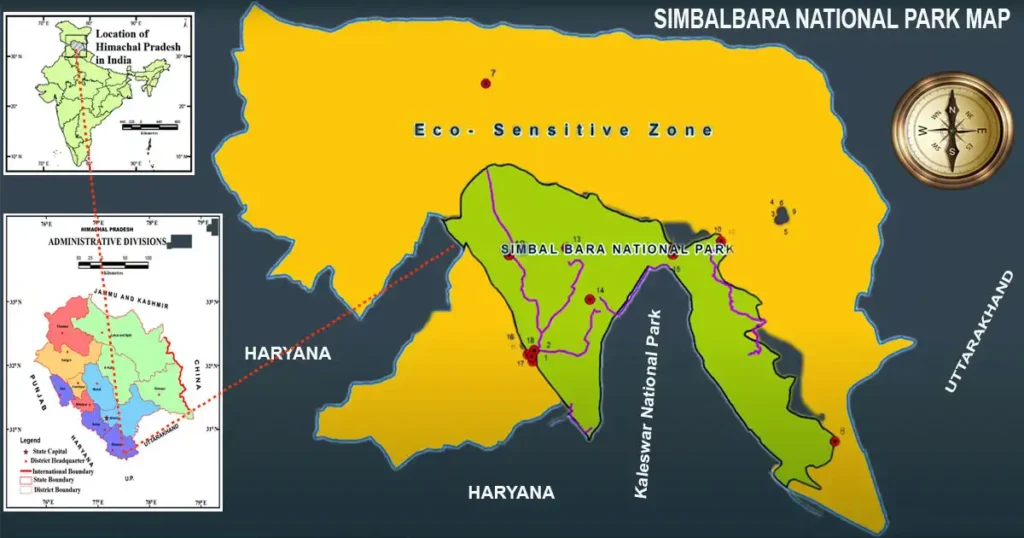
History of Simbalbara National Park
Once a hunting ground for the Maharaja of Sirmour in the erstwhile Sirmour State, this National Park was first notified as a game sanctuary in 1958. The wildlife sanctuary was notified in March 1974. The final notification of Simbalbara Wildlife Sanctuary under Section 26 of the Wildlife Protection Act, 1972 was notified on November 1, 1999, covering a total area of 19.03 sq. km.
On 28th July 2010, the Government of Himachal Pradesh designated Simbalbara Wildlife Sanctuary as Simbalbara National Park by including an additional area of 8.85 sq. km., thus comprising a total area of 27.88 sq. km. through its notification No. FFE-B-F (6) 11/2005, Dated Shimla-2, the 28th July 2010, to protect, propagate, developing wildlife, and its environment.
The Col. Sher Jung National Park alias Simbalbara National Park was given the status of National Park with effect from the 7th June 2013 vide notification no. FFE-B-F (6)-11/2005-II/Simbalbara.
On December 24, 2020, the Ministry of Environment, Forest, and Climate Change extended the boundaries of Simbalbara National Park Eco-sensitive Zone to 31.24 sq. km., with a range of zero to 8.064 km around the boundary of Col. Sher Jung National Park. The zero extent of the Eco-sensitive Zone is due to its contiguous border with Kalesar Wildlife Sanctuary and Kalesar National Park of Haryana on the north-western, southern, and south-eastern sides (Notification S.O. 4697(E), New Delhi, the 24th December 2020).
Simbalbara National Park Google Map
Geography and Climate of Simbalbara National Park
1. Geography:
The geography of Simbalbara National Park is mainly hilly, made up of loose sandstone and conglomerate, making it very prone to erosion. The park is located in the lower Shiwalik region and extends into the middle and upper Shiwaliks, with an elevation ranging from 350 to 700 meters above sea level.
The area is situated at the intersection of the Himalayan, Arid Zone, and Gangetic plains. The soil is highly porous, with poor water retention, and thus drains quickly. However, in many low-lying areas, springs appear, creating moist and cool patches that support riverine species.
The Simbalbara River flows through Simbalbara National Park and is a lifeline for the park’s plants and animals, providing essential water. The sanctuary also has several perennial waterholes, streams, and pools that originate from the Shivalik hills. The Park is indeed influenced by the Yamuna River, which flows close to the park, though it does not directly pass through it.
2. Climate:
The climate of Simbalbara National Park is influenced by its proximity to the Himalayas, retaining a typical continental monsoon climate with three distinct seasons: monsoon (July to September), winter (November to February), and summer (April to June), with October and March as transitional periods.
The park experiences significant variations in climate and microclimate due to its location in the Shiwaliks. Temperatures range from a minimum of -3°C in January to a maximum of 46°C in May. The sanctuary receives an average annual rainfall of about 1200 mm, with relative humidity ranging from 100% during the monsoon to 26% in summer.

Flora and Fauna of Simbalbara National Park
1. Flora:
The forests of Simbalbara National Park comprise northern tropical deciduous forests, falling under the 3C and 5B categories of the H.G. Champion and S.K. Seth classification. The floral diversity includes 63 species of trees, 42 species of shrubs, 42 species of herbs, 22 types of grasses, and five types of sages. It marks the western limit of Sal distribution in India. Sal (Shorea robusta) and Terminalia tomentosa are the principal species that form the top canopy here. On the riverine side, Jamun (Syzygium cumini), Cassia siamea, and Eucalyptus are present.
2. Fauna:
Simbalbara National Park boasts rich faunal biodiversity. Its fauna comprises 21 species of mammals, 140 species of birds, 17 species of reptiles, eight species of amphibians, 14 species of fish, and 126 species of insects, including 70 species of butterflies. These small creatures play vital roles in the autonomous ecosystem, contributing to pollination, seed dispersal, the food chain, and nutrient cycling.
Owing to the vast diversity at the primary producer level, there is a remarkable biodiversity of mammalian herbivores, which include Sambar deer, Nilgai, spotted deer, barking deer, goral, wild boar, porcupine, and Rhesus macaque.
Simbalbara marks the northern boundary of spotted deer and the southern boundary for goral distribution in Himachal Pradesh. It is also home to the scaly mammal, the pangolin, a rare animal.
Carnivorous mammals found here include the common leopard, jungle cat, leopard cat, palm civet, and jackal. The leopard is the top predator, along with the tiger, at the apex. Amphibians, porcupines, pangolins, palm civets, yellow-throated martens, and some birds are nocturnal inhabitants of this national park.
The movement of megaherbivores, such as elephants, is increasing in Simbalbara National Park compared to the previous year. It is the only protected area in Himachal Pradesh where the heritage animal of India, the tiger, is found in the wild. Tigers, once only found in folk tales of the valley, have shown their evident presence in the national park, with the first-ever image of a tiger in the state captured by a team here.
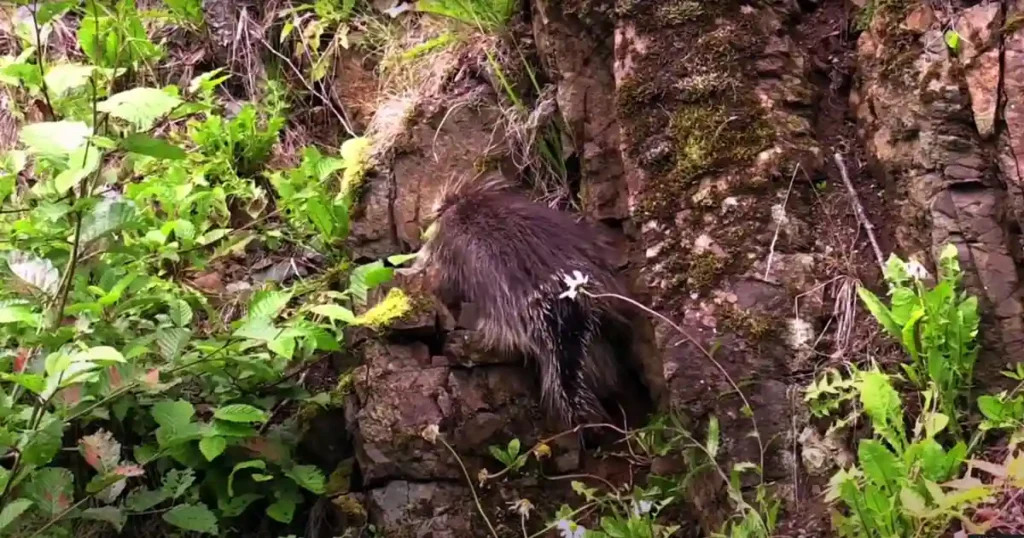
3. Avifauna
Some of the magnificent birds found in this national park include the Asian flycatcher, Indian roller, rufous-bellied niltava, hooded pitohui, dollar bird, drongo, kingfishers, Stork-billed kingfisher, three hornbill species including the greater hornbill, and many more. Crested serpent eagles, Brahminy kites, and long-billed vultures are the predators of avifauna here.
4. Reptilian fauna
Among the reptilian fauna, three out of India’s ‘big four’ venomous snakes, namely the spectacle cobra, common krait, and Russell’s viper, are found here. The king cobra has been recorded in neighboring forests. Simbalbara National Park was the site of the first recorded sighting of the black pond turtle in Himachal Pradesh in 2010.
In 2019, the Zoological Survey of India discovered an endemic fish here and named it the ‘Garra simbalbaraensis’ after the Simbalbara River. Garra Simbalbaraensis is distinguished by its unique features: a short, thick, unilobed proboscis projecting downwards above the transverse groove; a black spot at the upper angle of the gill opening; 32−33 lateral line scales, and a total of 32 vertebrae.
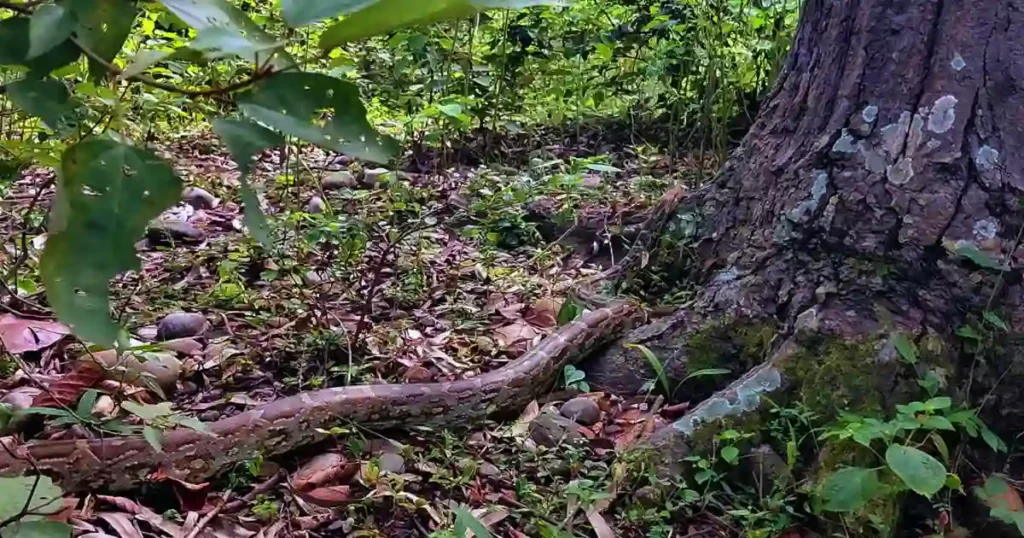
What Will You See at Simbalbara National Park?
Every year, a considerable number of tourists, especially wildlife enthusiasts, come to explore the real beauty of Simbalbara National Park. For those who want to spend more time in the most serene environment, Simbalbara National Park is the perfect destination, full of rich flora and fauna and surrounded by romantic wilderness, deep green valleys, mountains, rivers, and forests. There are also several points for adventurous and picturesque trekking tracks alongside the gurgling stream. The sanctuary is free from human population and habitation.
As there are no safaris available, visitors can trek on foot or drive a bike or four-wheeler for 14 to 18 km from the main gate of Simbalbara National Park, located at the Forest Division Office in Amargarh, to the Forest Rest House in Simbalbara. There is a rain shelter shed within 5 km of the main gate where visitors can take shelter if it rains. During trekking, one can spot many animals such as wild boars, snakes, and peacocks. There is also a watchtower along the trek from where visitors can enjoy panoramic views of the natural surroundings.
Visitors can soak in a beautiful view of the valley from the park. Walking trails are also present in the adjoining forests.

Simbalbara National Park ticket price
No ticket is required to enter Simbalbara National Park. Sunday is the park’s weekly holiday.
Best Time to Visit Simbalbara National Park
Following the rainy season, the period from October to March is an ideal time to visit the park. During this time, much of the undergrowth is flattened, making it easier to spot shy animals.
How to go to Simbalbara National Park
1. By air: The nearest airport is Dehradun (70 km) from the park.
2. By rail: The nearest railway station is Dehradun (60 km) and Yamunanagar (70 km) from the Simbalbara National Park.
3. By road: Approachable from Paonta Sahib (20 km), Yamunananagar (70 km), Dehradun (70 km) or Chandigarh
Where to stay
There is a Forest Rest House at Simbalbara and Mantaruwala in Paonta Sahib, as well as an HPTDC hotel in Paonta Sahib.
Conclusion
The Simbalbara National Park is located in the Paonta Valley of the Sirmaur district in Himachal Pradesh, on the lower hills of the Shivalik ranges in the Indian Himalayas. This sanctuary provides refuge to various animals such as wild boar, sambar, chital, goral, spotted deer, and more. It is a shining example of wildlife conservation efforts by the Himachal Tourism Department.
The sanctuary is adorned with forests of sal trees and grassy glades, offering adventurous and picturesque trekking trails alongside babbling streams. Free from human population and habitation, it provides a serene haven for wildlife to thrive undisturbed.
FAQ
Q. Which River flows through Simbalbara National Park?
A. The Simbalbara River flows through Simbalbara National Park and is a lifeline for the park’s plants and animals, providing essential water. The sanctuary also has several perennial waterholes, streams, and pools that originate from the Shivalik hills.
Q. Which animal is protected in Simbalbara National Park?
A. The protected animals in Simbalbara National Park include the Common Leopard, which is the apex predator of the park. There have been rare reports of Tigers in the protected areas. Among herbivores, one can spot Wild Boars, Chital, and Sambar in groups, while the Himalayan Goral typically inhabits the ridges.
Q. Where is Simbalbara National Park situated?
A. Covering an area of 27.88 sq. km, Simbalbara National Park is located in the Paonta Valley of Sirmour District in Himachal Pradesh, India. It is also known as Col. Sher Jung National Park, named after the famous freedom fighter and ardent environmentalist Colonel Sher Jung.
You May Also Like
- Pin Valley National Park
- Khirganga National Park
- Inderkilla National Park
- Murlen National Park
- Phawngpui National Park

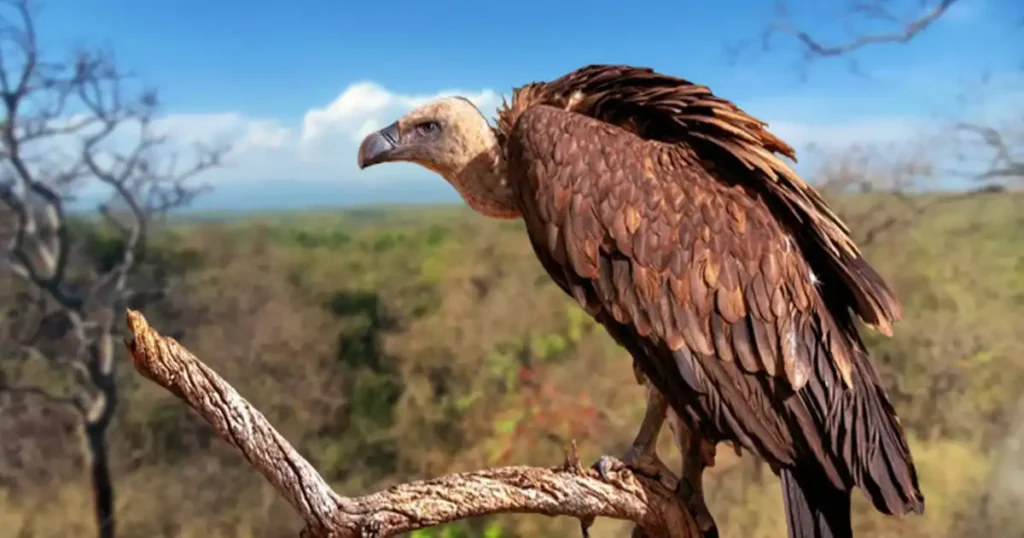
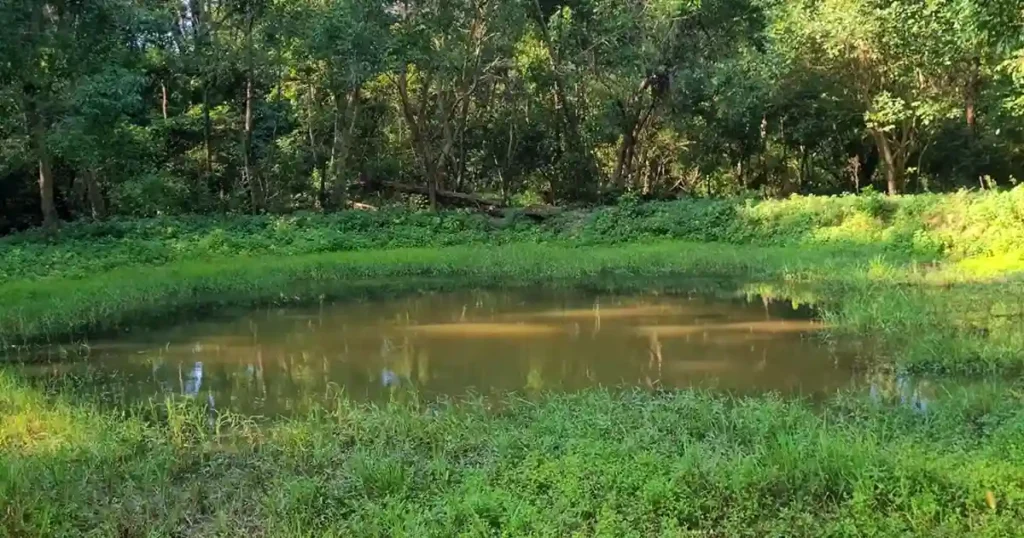


6 thoughts on “Simbalbara National Park”